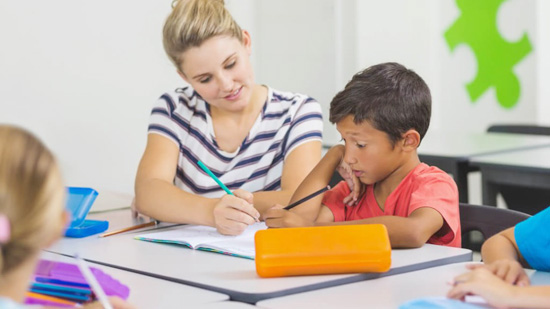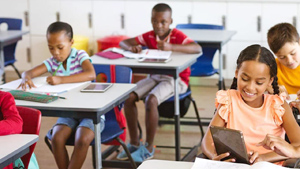Teachers play a critical role in advocating for students with disabilities, ensuring they receive the support and resources they need to thrive academically and socially. With approximately 14% of students in the United States having a disability, it is essential that teachers have the knowledge and tools to effectively advocate for their students.
In this article, we will explore strategies and tips for teachers to become strong advocates for students with disabilities. From understanding students’ individual needs and rights to establishing effective communication with parents and professionals, advocating for students with disabilities goes beyond the classroom. We will also discuss the importance of fostering an inclusive and supportive classroom environment to promote the success of all students, regardless of their abilities.

Photo by senteacherstraining
By becoming effective advocates, teachers can contribute to breaking down barriers and ensuring equal opportunities for students with disabilities. So if you’re a teacher looking to make a difference and support your students to the best of your ability, keep reading to discover how you can advocate for students with disabilities effectively.
Advocating for students with disabilities
Advocating for students with disabilities is crucial for their educational and social development. It ensures that they have equal access to education and the necessary support to reach their full potential. When teachers advocate for students with disabilities, they help break down barriers and create inclusive environments that foster learning and growth. By taking an active role in advocating for their students, teachers can make a significant impact on their lives and future success.
One of the key reasons why advocating for students with disabilities is so important is because it helps ensure their rights are protected. Students with disabilities are entitled to certain accommodations and support services under the law. Teachers who understand these rights can help ensure that their students receive the necessary services and accommodations to thrive academically. It is essential for teachers to familiarize themselves with laws such as the Individuals with Disabilities Education Act (IDEA) and Section 504 of the Rehabilitation Act to effectively advocate for their students.
Another reason why advocating for students with disabilities is vital is that it helps address the unique challenges they may face. Students with disabilities often encounter barriers that hinder their educational progress. These barriers can include physical obstacles, discriminatory attitudes, and lack of access to appropriate resources. By advocating for their students, teachers can work to identify and address these barriers, ensuring that students with disabilities have the same opportunities as their peers.
Advocating for students with disabilities also promotes a more inclusive and accepting society. When teachers advocate for their students, they send a powerful message that everyone deserves equal opportunities and respect. By creating inclusive classroom environments, teachers can help foster a sense of belonging and acceptance among all students. This not only benefits students with disabilities but also creates a positive learning environment for all students.
Rights of students with disabilities
To effectively advocate for students with disabilities, teachers must have a solid understanding of their rights. Students with disabilities are protected under various federal laws, including the Individuals with Disabilities Education Act (IDEA) and Section 504 of the Rehabilitation Act. These laws ensure that students with disabilities have equal access to education and the necessary accommodations and support services.
Under IDEA, students with disabilities are entitled to a free and appropriate public education (FAPE). This means that schools must provide students with disabilities with the necessary services and accommodations to meet their individual needs. These services may include specialized instruction, assistive technology, counseling, and related services. Teachers should familiarize themselves with the specific rights and protections outlined in IDEA to effectively advocate for their students.
Section 504 of the Rehabilitation Act prohibits discrimination against individuals with disabilities in any program or activity receiving federal financial assistance. This law ensures that students with disabilities have equal access to education and services, even if they do not qualify for special education services under IDEA. Teachers should understand the requirements and protections provided by Section 504 to advocate for students who may not qualify for an Individualized Education Program (IEP) but still require accommodations.
In addition to federal laws, teachers should also be aware of any state or local laws that may provide additional protections for students with disabilities. By staying informed about the rights and protections afforded to students with disabilities, teachers can effectively advocate for their students and ensure they receive the support they need to succeed.
Identifying and addressing barriers to education for students with disabilities
Students with disabilities often face unique barriers that can hinder their educational progress. It is important for teachers to identify and address these barriers to ensure that students with disabilities have equal access to education and opportunities for success.
One common barrier that students with disabilities may face is physical obstacles within the school environment. This can include inaccessible buildings, classrooms, or restrooms. Teachers can work with school administrators and support staff to address these physical barriers by advocating for necessary modifications or accommodations. Simple changes, such as installing ramps or providing assistive devices, can make a significant difference in a student’s ability to navigate the school environment independently.
Another barrier that students with disabilities may encounter is a lack of appropriate resources or materials. Teachers can advocate for their students by ensuring that they have access to the necessary instructional materials, assistive technology, and specialized equipment. This may involve collaborating with school administrators, special education coordinators, and support staff to secure the resources needed to meet the individual needs of students with disabilities.
Discriminatory attitudes and lack of awareness can also create barriers for students with disabilities. Teachers can help address these barriers by promoting disability awareness and fostering a culture of inclusion within the classroom and school community. By educating their students and colleagues about disabilities and promoting understanding and acceptance, teachers can help break down stereotypes and create a supportive environment for students with disabilities.
Addressing barriers to education for students with disabilities requires ongoing collaboration and communication with school staff, parents, and professionals. By working together, teachers can identify and address barriers effectively, ensuring that students with disabilities have equal opportunities to succeed academically and socially.
Collaborating with parents and guardians in advocating for students with disabilities
Collaboration with parents and guardians is essential in advocating for students with disabilities. Parents and guardians have valuable insights into their child’s strengths, needs, and preferences. By working together, teachers and parents can create a unified approach to advocating for students with disabilities, ensuring that their individual needs are met.
Open and effective communication is the foundation of successful collaboration between teachers and parents. Regular communication allows teachers to gain a deeper understanding of the unique needs and challenges faced by their students. It also provides an opportunity for parents to share their concerns, insights, and goals for their child’s education.
When communicating with parents, it is important for teachers to listen actively and empathetically. Each student with a disability is unique, and their needs may vary. By actively listening to parents’ perspectives and concerns, teachers can better advocate for their students and tailor their instructional approaches to meet their individual needs.
In addition to regular communication, teachers and parents can collaborate on developing individualized education plans (IEPs) for students with disabilities. IEPs outline the specific goals, accommodations, and services that will support the student’s educational needs. By working together to create IEPs, teachers and parents can ensure that the student’s individual needs are addressed and that they receive the appropriate support services.
Collaboration with parents also extends beyond the classroom. Teachers can support parents in advocating for their children by providing them with information and resources related to their child’s disability. This may include recommending books, websites, or support groups that can provide additional guidance and support. By empowering parents with knowledge and resources, teachers can help them become effective advocates for their child both in and outside of the school environment.
Building a supportive and inclusive classroom environment
Creating a supportive and inclusive classroom environment is essential for the success of all students, including those with disabilities. When students feel valued, accepted, and supported, they are more likely to engage in learning and reach their full potential. Here are some strategies teachers can implement to foster an inclusive classroom environment:
Promote positive peer interactions
Encourage students to interact and collaborate with one another. Foster a culture of acceptance and respect by teaching empathy and promoting kindness. Create opportunities for students to work together and learn from one another’s unique perspectives and experiences.
Use inclusive teaching strategies
Utilize teaching strategies that cater to diverse learning styles and abilities. Differentiate instruction to meet the individual needs of students with disabilities, providing them with appropriate accommodations and modifications. Use a variety of instructional materials and methods to engage all students and make learning accessible.
Establish clear expectations and routines
Clearly communicate expectations for behavior and academic performance. Establish a predictable and structured classroom environment to help students feel safe and secure. Consistency and clear routines can benefit all students, including those with disabilities, by providing a sense of stability and reducing anxiety.
Promote self-advocacy skills
Teach students with disabilities how to advocate for themselves and their needs. Encourage them to communicate their challenges, preferences, and goals to teachers and peers. By empowering students to self-advocate, teachers can help foster independence and confidence.
Provide support and resources
Offer support and resources to students with disabilities, such as additional time for assignments or access to assistive technology. Ensure that students are aware of the available resources and know how to access them. Provide a safe and welcoming space for students to seek assistance or ask questions.
Creating a supportive and inclusive classroom environment requires ongoing effort and reflection. Teachers should continuously assess and adjust their instructional practices to meet the needs of all students. By fostering an inclusive environment, teachers can create a positive and empowering learning experience for students with disabilities.
Utilizing assistive technology and accommodations for students with disabilities
Assistive technology and accommodations play a crucial role in supporting students with disabilities and promoting their success in the classroom. Assistive technology refers to devices, software, or equipment that helps individuals with disabilities perform tasks that they may have difficulty completing independently.
Accommodations, on the other hand, are adjustments made to the learning environment or instructional methods to support students with disabilities. Here are some examples of assistive technology and accommodations that can benefit students with disabilities:
- Text-to-speech software: This technology allows students with reading difficulties or visual impairments to have written text read aloud to them. It can help students access and comprehend written materials more effectively.
- Speech recognition software: This type of software enables students with physical disabilities or difficulties in writing to dictate their thoughts and have them transcribed into written text.
- Visual aids: Visual aids, such as charts, diagrams, and graphic organizers, can help students with learning disabilities or attention difficulties better understand and organize information.
- Extra time for assignments or tests: Providing additional time for students with disabilities can help reduce anxiety and give them the necessary time to complete tasks at their own pace.
- Flexible seating: Offering flexible seating options, such as standing desks, stability balls, or bean bags, can benefit students with physical disabilities or sensory processing difficulties.
- Note-taking assistance: Providing students with disabilities with access to notes or providing them with a peer note-taker can help ensure that they have access to all the information covered in class.
- Alternative assessment methods: Allowing students with disabilities to demonstrate their knowledge and skills through alternative means, such as oral presentations or projects, can accommodate their unique abilities and strengths.
When utilizing assistive technology and accommodations, it is important for teachers to collaborate with students, parents, and professionals to determine the most appropriate tools and strategies for each individual student. Regular evaluation and adjustment of assistive technology and accommodations are necessary to ensure that students’ needs are met effectively.
Providing individualized education plans (IEPs) for students with disabilities
Individualized Education Plans (IEPs) are essential tools for supporting students with disabilities. An IEP is a written document that outlines the specific goals, accommodations, and services that will support the student’s educational needs. Developing and implementing effective IEPs requires collaboration among teachers, parents, and other professionals involved in the student’s education. Here are the key components of an IEP:
Present levels of performance
This section describes the student’s current academic and functional abilities, as well as their strengths and weaknesses. It provides a baseline for setting goals and determining appropriate accommodations and services.
Annual goals and objectives
The IEP should include measurable goals that the student will work towards over the course of the year. These goals should be specific, achievable, and tailored to the individual needs of the student.
Accommodations and modifications
The IEP should outline the accommodations and modifications that will be provided to support the student in accessing the curriculum and participating in classroom activities. These may include assistive technology, preferential seating, extended time for assignments, or modified assignments.
Related services
Related services are additional support services that students with disabilities may require to benefit from their education. These services may include speech therapy, occupational therapy, counseling, or physical therapy. The IEP should specify the frequency, duration, and location of these services.
Transition planning
For students transitioning to post-secondary education or employment, the IEP should include transition goals and services that will support their successful transition. This may include vocational training, job placement assistance, or college preparation.
Progress monitoring and reporting
The IEP should include a process for regularly monitoring the student’s progress towards their goals. Teachers should provide progress reports to parents and involve them in the decision-making process regarding any necessary adjustments to the IEP.
Developing and implementing effective IEPs requires ongoing collaboration and communication among all stakeholders involved in the student’s education. By tailoring instruction and support to meet the individual needs of students with disabilities, IEPs can help ensure their success in the classroom and beyond.
Empowering students with disabilities to self-advocate
Empowering students with disabilities to self-advocate is an important aspect of advocating for their success. By teaching students to advocate for themselves, teachers can help foster independence, confidence, and self-determination. Here are some strategies for empowering students with disabilities to self-advocate:
Teach self-awareness: Help students understand their strengths, weaknesses, and learning styles. Encourage them to reflect on their own needs and preferences and identify strategies that work best for them.
Develop communication skills: Teach students effective communication skills, such as expressing their needs, asking for help, and articulating their goals. Provide opportunities for students to practice these skills in a safe and supportive environment.
Promote self-confidence: Encourage students to take pride in their abilities and achievements. Celebrate their successes and provide constructive feedback to help them grow and improve.
Encourage problem-solving skills: Teach students problem-solving strategies and encourage them to independently
Conclusion
Teachers play a crucial role in advocating for students with disabilities. By understanding students’ individual needs, rights, and the laws that protect them, teachers can effectively advocate for their students and ensure they receive the support and accommodations they need to succeed academically and socially.
Advocating for students with disabilities goes beyond the classroom and contributes to breaking down barriers, fostering inclusive environments, and promoting equal opportunities for all students. By taking an active role in advocating for their students, teachers can make a significant impact on their lives and future success.



